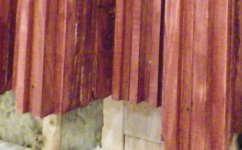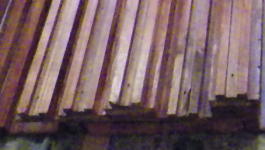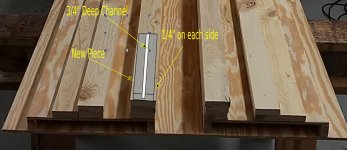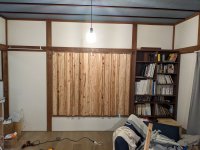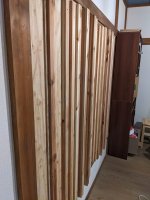As I described earlier on, I added 1 1/2 inch wide, 3/,4 inch thick wooden pieces, each with a 1/2 inch wide, 3/8 inch deep channels down the middle of them. This makes these diffusers what Tim Perry calls Leanfusers, diffusing higher in frequency. I also modulated the various individual panels by varying their height off the back wall. This modulation helps to improve diffusion down below 1000 hz.
I did take some pictures and at some point I will post them.
Hey Retsel, did you ever get any pics of what you did here? I went back and tried to figure out what you put on top of the standard depot diffusers to reflect higher frequencies. But somehow I can't get my head around what it looks like.
I'm getting ready to make a bunch of these and thought it might be useful to add this. I'm certainly going to put them different distanced off the wall like you suggested, that one I can figure out
Thanks, gabo
Diffuser photos
Here are a couple more pictures which I hope shows better what I did (I hope that they load...).
Again, I took 1x2 pieces and ripped a 3/8 inch deep channel down the middle of the pieces when they were sitting with the wide side down. I mounted these in the center of each 2 1/2 inch wide "step" of the stepfuser.
Here are a couple more pictures which I hope shows better what I did (I hope that they load...).
Again, I took 1x2 pieces and ripped a 3/8 inch deep channel down the middle of the pieces when they were sitting with the wide side down. I mounted these in the center of each 2 1/2 inch wide "step" of the stepfuser.
Attachments
Here are a couple more pictures which I hope shows better what I did (I hope that they load...).
Again, I took 1x2 pieces and ripped a 3/8 inch deep channel down the middle of the pieces when they were sitting with the wide side down. I mounted these in the center of each 2 1/2 inch wide "step" of the stepfuser.
How wide is the channel?
I have a dado blade, so I can cut the channel any width I need.
I took a pic of one of my diffusers and tried to put some annotation on top. Is this correct?
gabo
Attachments
Thanks, I didn't really pay attention to the depth, I'll make them 3/8's as you did.
I see, you're using a 1x2 but the actual dimension of it are 1 3/4 wide instead of 2. So that leaves closer to 1/2" on either side exposed.
would be interesting to see if someone could put that profile into AFMG Reflex to see what it does. I don't want to lose the low end performance. Having the low end extend down to around 450hz is one of the great things about this diffuser.
But improved performance above 5K is also a great thing. Once we finish the room we're going to put these in, I'll take some shots of the room with REW and see where things stand.
The room has a vaulted ceiling that is going to have a number of hanging traps and we're going to trap all the corners. Once we get that done, a few sweeps with REW will help see what things look like at all spectrums.
Typically rooms have longer reverb times as you get lower in frequency, with the highest as you get below the Schroeder frequency. This diffuser isn't going to do much from 450hz down to Schroeder and virtually nothing below that. So those frequencies will need to be controlled with absorption.
Above Schroeder we're more concerned with comb filtering, the standard diffuser looks to do a good job of that up to around 5K or 6K. Above that there may not be all that much comb filtering anyway, and the reverb times will be down there as well.
So putting in the absorption to try to control below Schroeder first, then taking some REW readings will help us to understand what this addition will do. I have no doubt it would be a good thing, but there is a cost in time, money, and a few inches of additional space.
I'll try to take the profile from the first post here and add this to it just so we're totally clear on what to do.
Thanks for the help!! gabo
I see, you're using a 1x2 but the actual dimension of it are 1 3/4 wide instead of 2. So that leaves closer to 1/2" on either side exposed.
would be interesting to see if someone could put that profile into AFMG Reflex to see what it does. I don't want to lose the low end performance. Having the low end extend down to around 450hz is one of the great things about this diffuser.
But improved performance above 5K is also a great thing. Once we finish the room we're going to put these in, I'll take some shots of the room with REW and see where things stand.
The room has a vaulted ceiling that is going to have a number of hanging traps and we're going to trap all the corners. Once we get that done, a few sweeps with REW will help see what things look like at all spectrums.
Typically rooms have longer reverb times as you get lower in frequency, with the highest as you get below the Schroeder frequency. This diffuser isn't going to do much from 450hz down to Schroeder and virtually nothing below that. So those frequencies will need to be controlled with absorption.
Above Schroeder we're more concerned with comb filtering, the standard diffuser looks to do a good job of that up to around 5K or 6K. Above that there may not be all that much comb filtering anyway, and the reverb times will be down there as well.
So putting in the absorption to try to control below Schroeder first, then taking some REW readings will help us to understand what this addition will do. I have no doubt it would be a good thing, but there is a cost in time, money, and a few inches of additional space.
I'll try to take the profile from the first post here and add this to it just so we're totally clear on what to do.
Thanks for the help!! gabo
I'm not totally sure about this but if you can increase the full width of each of the diffusers, then the effective frequency increases downwards, yes? I did a number of basic modules with the 12mm ply and using a pair of the 7 units in the 'offset' array, the diffusion was effective down to about 300Hz (I was a bit surprised at this) but the re-arranged 5 unit array, didn't go much below 400.
A few years ago there were products available from 8th Nerve Audio (or Eigth Nerve) that produced corner 'wedges' and freestanding panels - I think these had their origins in Michael Green's idea about room boundary effects but it all seems to be gone now
With my current OB midrange/tops setup, I'm learning about the measurements of Rt30 and such things - slow going, unfortunately.
I'm still amazed at the benefits of these simple-man styrene diffusers - maybe not as effective as the solid timber ones but much easier to make and handle. I asked the local people here about the possibility of plastic coating them (like they do with the handles on pliers, etc) but they just laughed - I thought it might have worked, but silly me! Now I'm just slopping on heavy coats of that exterioir paint they use on foam siding for houses and it seems to work quite well.
The folded metal ones (7 segment, 420mm wide) turned out to be a real PItA - must try again (maybe after Covid) and maybe make them in 2 parts this time and use something other than expanding foam to stop the ringing as they used to do years ago for studio walls and the basic Schroeder design.
A few years ago there were products available from 8th Nerve Audio (or Eigth Nerve) that produced corner 'wedges' and freestanding panels - I think these had their origins in Michael Green's idea about room boundary effects but it all seems to be gone now
With my current OB midrange/tops setup, I'm learning about the measurements of Rt30 and such things - slow going, unfortunately.
I'm still amazed at the benefits of these simple-man styrene diffusers - maybe not as effective as the solid timber ones but much easier to make and handle. I asked the local people here about the possibility of plastic coating them (like they do with the handles on pliers, etc) but they just laughed - I thought it might have worked, but silly me! Now I'm just slopping on heavy coats of that exterioir paint they use on foam siding for houses and it seems to work quite well.
The folded metal ones (7 segment, 420mm wide) turned out to be a real PItA - must try again (maybe after Covid) and maybe make them in 2 parts this time and use something other than expanding foam to stop the ringing as they used to do years ago for studio walls and the basic Schroeder design.
I'm not totally sure about this but if you can increase the full width of each of the diffusers, then the effective frequency increases downwards, yes? I did a number of basic modules with the 12mm ply and using a pair of the 7 units in the 'offset' array, the diffusion was effective down to about 300Hz (I was a bit surprised at this) but the re-arranged 5 unit array, didn't go much below 400.
A few years ago there were products available from 8th Nerve Audio (or Eigth Nerve) that produced corner 'wedges' and freestanding panels - I think these had their origins in Michael Green's idea about room boundary effects but it all seems to be gone now
With my current OB midrange/tops setup, I'm learning about the measurements of Rt30 and such things - slow going, unfortunately.
I'm still amazed at the benefits of these simple-man styrene diffusers - maybe not as effective as the solid timber ones but much easier to make and handle. I asked the local people here about the possibility of plastic coating them (like they do with the handles on pliers, etc) but they just laughed - I thought it might have worked, but silly me! Now I'm just slopping on heavy coats of that exterioir paint they use on foam siding for houses and it seems to work quite well.
The folded metal ones (7 segment, 420mm wide) turned out to be a real PItA - must try again (maybe after Covid) and maybe make them in 2 parts this time and use something other than expanding foam to stop the ringing as they used to do years ago for studio walls and the basic Schroeder design.
I don't think you can do it with width alone, I think you have to increase the depth of the channels.
How did you offset your two unit module vs your 5 unit module? The offsetting of the panels increased the depth of the entire unit, which should lower the frequency, but I'm not sure how to predict it.
As I get closer to doing my project, I may download the free trial of AFMG Reflex and play with it for a few days to see if I can maximize the effect based on what I'm going to build.
This has been fascinating and I'm really anxious to get this project moving so I can see what this really does. I have high hopes for the live recording room using these panels.
gabo
Hi gabo,
If you're contemplating using these 'devices' in a live recording studio, the freq response and Rt30 (actually Rt60 for you) needs to be much closer to +/-2db (or better, if you can afford it) over the freq range at the board (and the dynamics/volume too) so the application of the diffusers needs to be much more integrated in the design of the overall acoustics - the study of d'Antonia, etc will be of great assistance here too, not just the 'leanfusers' themselves.
That is, if you haven't already done this, it'll save you 'going around in circles' (like I did/still do at times!)
The adjustment of the level of 'indirect sound', etc will directly affect the quality of the recording at the 'desk' - this is much more critical than the 'at home' reproduction and the balance of absorbers/diffusers/traps generally creates a far 'drier' sound than you'd tolerate for home listening but is necessary for successful recording quality.
Some of the guys out here try to reduce the need for the later mastering stage (esp home recording for direct sales), but this is not so easy to do both at once and is rather time consuming - rather tricky indeed to balance the use/compensations of dsp for deficiencies of room acoustics at the recording stage esp if using high quality monitors
Mind you, this is just my view and others may be able to offer better ideas for you at this planning stage - all the best ...
If you're contemplating using these 'devices' in a live recording studio, the freq response and Rt30 (actually Rt60 for you) needs to be much closer to +/-2db (or better, if you can afford it) over the freq range at the board (and the dynamics/volume too) so the application of the diffusers needs to be much more integrated in the design of the overall acoustics - the study of d'Antonia, etc will be of great assistance here too, not just the 'leanfusers' themselves.
That is, if you haven't already done this, it'll save you 'going around in circles' (like I did/still do at times!)
The adjustment of the level of 'indirect sound', etc will directly affect the quality of the recording at the 'desk' - this is much more critical than the 'at home' reproduction and the balance of absorbers/diffusers/traps generally creates a far 'drier' sound than you'd tolerate for home listening but is necessary for successful recording quality.
Some of the guys out here try to reduce the need for the later mastering stage (esp home recording for direct sales), but this is not so easy to do both at once and is rather time consuming - rather tricky indeed to balance the use/compensations of dsp for deficiencies of room acoustics at the recording stage esp if using high quality monitors
Mind you, this is just my view and others may be able to offer better ideas for you at this planning stage - all the best ...
Yes, these will not be used in the control room, which is where the "desk" is and monitor speakers, etc. That will be heavily treated and designed and will be very dry.
I'm going to use these in the live recording room. Which has different acoustics and isn't as dry. Some of these rooms are actually quite lively. But you want to control peaks, standing waves, echoes, and comb filtering where possible.
So essentially what I'm looking for is a very pleasing sounding room. Something that you go into and it feels bigger than it is, not dry, and just sounds good when you sing.
So the idea is to heavily trap the ceiling and the corners to control the low end as much as possible. The 4 remaining walls will be a bit of an experiment. We're either going to use complete coverage with the arrays of these panels, so pretty much total diffusion. Or we're going to alternate absorption and diffusion.
I want to try the full coverage diffusion first and see how that sounds. If it's too lively or doesn't sound good, we'll start selectively replacing panel sections with absorption.
Even a bit too lively is ok because we're also going to build many 6" or 8" stand alone "gobos" that can be arranged around whatever is being recorded to create a more dead area if required.
gabo
I'm going to use these in the live recording room. Which has different acoustics and isn't as dry. Some of these rooms are actually quite lively. But you want to control peaks, standing waves, echoes, and comb filtering where possible.
So essentially what I'm looking for is a very pleasing sounding room. Something that you go into and it feels bigger than it is, not dry, and just sounds good when you sing.
So the idea is to heavily trap the ceiling and the corners to control the low end as much as possible. The 4 remaining walls will be a bit of an experiment. We're either going to use complete coverage with the arrays of these panels, so pretty much total diffusion. Or we're going to alternate absorption and diffusion.
I want to try the full coverage diffusion first and see how that sounds. If it's too lively or doesn't sound good, we'll start selectively replacing panel sections with absorption.
Even a bit too lively is ok because we're also going to build many 6" or 8" stand alone "gobos" that can be arranged around whatever is being recorded to create a more dead area if required.
gabo
It's good that you're following a plan - so many studios use an 'add-hock' method of determining sound quality, sometimes searching for a 'distinct sound characteristic' - aiming for a bigger room sound acoustically is great for vocalists and especially harmonies altho much of this is done electronically these days and using headphones (even good systems) takes quite a lot of getting used to for most people.. .
Yes, there is definitely a plan. Many books and conversations with professionals as well as being on many forums for various parts of the design. And we have lots of experience as both artists and engineer/producer. I've worked in many studios around the world for about 40 years.
And this is the 4th studio we've built, so we've learned a few things along the way.
One thing we've learned that is interesting is that you can create a studio that is very much "by the book" in terms of acoustics and it will be good. But there are many many studios like this, so you don't have anything that can't be had at many other locations.
So one objective is to create one room that sounds different. Even if it's not as good for some things, as long as it's really good for some things. This gives you a room that has a mystique and attracts clients. Other rooms will be done "by the book" so that will exist as well.
Go to the internet and search for "Blackbird Studio C" which is a dolby atmos room in Nashville that is totally done with diffusion. It's quite famous.
At the same time, we're not a big studio with unlimited budget, so we can't just purchase what we need off the shelf. So there will be sweat equity and a lot of DIY pieces. Which in itself will create a charm and mystique.
It's a long process but we have some incredible people who have some unique skills, so it'll all come together.
gabo
And this is the 4th studio we've built, so we've learned a few things along the way.
One thing we've learned that is interesting is that you can create a studio that is very much "by the book" in terms of acoustics and it will be good. But there are many many studios like this, so you don't have anything that can't be had at many other locations.
So one objective is to create one room that sounds different. Even if it's not as good for some things, as long as it's really good for some things. This gives you a room that has a mystique and attracts clients. Other rooms will be done "by the book" so that will exist as well.
Go to the internet and search for "Blackbird Studio C" which is a dolby atmos room in Nashville that is totally done with diffusion. It's quite famous.
At the same time, we're not a big studio with unlimited budget, so we can't just purchase what we need off the shelf. So there will be sweat equity and a lot of DIY pieces. Which in itself will create a charm and mystique.
It's a long process but we have some incredible people who have some unique skills, so it'll all come together.
gabo
The one thing that seems so understated is the people who work in the studio, not just the 'names' but you seem to have a good handle on that - there are many really top quality equipped studios around (big and small) but so many "just don't cut it" because of the personnel - pity really.
I've often wondered who on earth counted all those many thousands of unique sized (?) sticks on the walls of studio 'C' and how do they keep the dirt off them!
I was listening to a fairly recent (to me, anyway!) set of monitors by the name of Jones-Scanlon Big Red Studio Monitors - amazing clarity and effortless dynamics and a real marvel with female harmonies, go figure.
I've often wondered who on earth counted all those many thousands of unique sized (?) sticks on the walls of studio 'C' and how do they keep the dirt off them!
I was listening to a fairly recent (to me, anyway!) set of monitors by the name of Jones-Scanlon Big Red Studio Monitors - amazing clarity and effortless dynamics and a real marvel with female harmonies, go figure.
Haha, yes good question on the sticks at studio c, how to keep the dust off them is a big question. Our mini version with just depot diffuser's will at least be easier to clean. And our room isn't going to be for mixing dolby atmos recordings, not for mixing at all.
Yes, those Big Red's are serious monitors!
And I totally agree about the "people" in studios. That's actually how we built our first studio. We had recorded in a number of very very high profile studios and got lack luster recordings. Places that had many gold/platinum recordings.
Took us a while to figure out that many of the really big studios are good at recording, and have great rooms and equipment. But if you want a good record, you need to bring your own engineer and producer. Which is what all the big record labels do.
Some of the best recordings were made in some really bad rooms, but the guy doing it knew what he was doing. We got better records from our living room than we did from multi-million dollar studios back in the early 80s. Mixing, producing, and engineering is a real thing and like many things there are some people who just have an ear for it.
gabo
Yes, those Big Red's are serious monitors!
And I totally agree about the "people" in studios. That's actually how we built our first studio. We had recorded in a number of very very high profile studios and got lack luster recordings. Places that had many gold/platinum recordings.
Took us a while to figure out that many of the really big studios are good at recording, and have great rooms and equipment. But if you want a good record, you need to bring your own engineer and producer. Which is what all the big record labels do.
Some of the best recordings were made in some really bad rooms, but the guy doing it knew what he was doing. We got better records from our living room than we did from multi-million dollar studios back in the early 80s. Mixing, producing, and engineering is a real thing and like many things there are some people who just have an ear for it.
gabo
- Home
- General Interest
- Room Acoustics & Mods
- Making easy DIY "Depot" sound Diffuser panels, step by step
